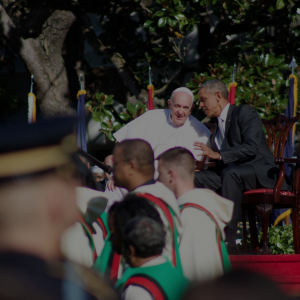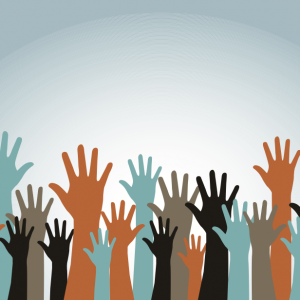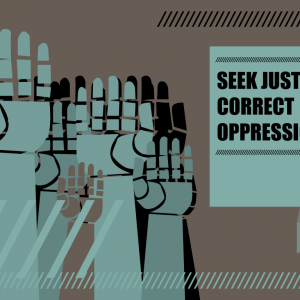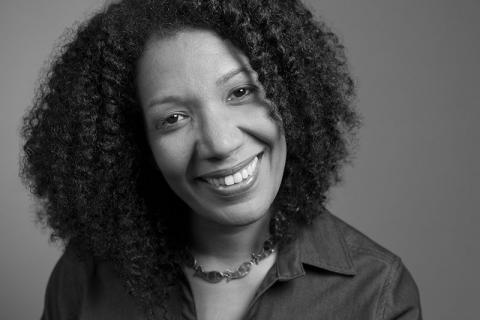
Lisa Sharon Harper, a former Sojourners columnist, is the founder and president of Freedom Road and author of Fortune and The Very Good Gospel. You can follow her work at lisasharonharper.com.
Posts By This Author
Death Does Not Reign
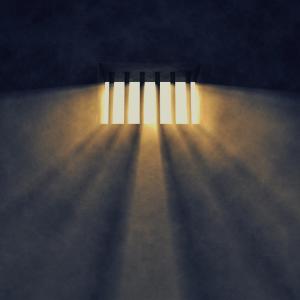
nobeastsofierce / Shutterstock
POPE FRANCIS called our country to honor the sacredness of all human life. He called on Congress to embrace a consistent ethic of life—to abolish the death penalty. The state killed no one while Francis walked among us. But three days after his departure, blood flowed.
Six people in five states were scheduled to be executed in the U.S. within one week of each other in the beginning of October:
Wednesday, Sept. 30. Kelly Gissendaner, convicted for the orchestration of the 1997 murder of her husband, converted to Christianity while on death row in Georgia. Gissendaner, a respected student of theology, was put to death after three failed Supreme Court appeals.
Wednesday, Sept. 30. Richard Glossip, who is widely believed to be innocent of the 1997 murder-for-hire for which he was convicted, was scheduled to be executed in Oklahoma, but Gov. Mary Fallin issued a stay of execution. Fallin offered the stay not because she believed that Glossip was innocent, but rather because of questions over whether the state possessed the legal drug protocol to put him to death.
Thursday, Oct. 1. Alfredo Prieto was executed in Virginia for the rape and murder of a woman and her boyfriend in 1988. Prieto was believed to be a serial murderer with an IQ below 70, according to Amnesty International. Prieto had an appeal pending when the state killed him.
Friday, Oct. 2. Kimber Edwards was convicted of the murder-for-hire of his ex-wife in 2000, but another man recently confessed to having acted alone. Edwards, who has autism, originally confessed to the crime, but at his trial and ever since he has said he was innocent. His death sentence was commuted to life in prison by Missouri Gov. Jay Nixon.
U.S. Military Action Has Never Brought Peace to the Middle East and It Won't Now

Image via thaikrit / Shutterstock
“U.S. military intervention is the problem, not the solution. Since the U.S. started bombing Iraq and Syria last year, ISIS has grown stronger.”
In the months since Cortright’s charge the world has witnessed millions of Syrian citizens fleeing the conflict. Having saturated the capacity of neighboring nations to accept refugees, displaced Syrians have continued north through Turkey and Eastern Europe, en route to Germany and neighboring countries. In September, Russia inserted itself into the Syrian military calculus, offering military support for, it claimed, the Assad regime’s fight against ISIS. Instead Russian bombs showered insurgent Syrian rebel forces. Recent reports confirm that Russia is actually helping Assad retake Aleppo, the largest city in Syria, from insurgent forces, with an Iranian assist.
In moments like these it is tempting to stand in solidarity with the disciple Peter, who tried to defend the helpless with military might. When Jesus was seized by temple police, Peter took out his blade and sliced off the ear of the high priest’s servant, Malchus. (Matt. 26:51-56, Luke 22:50, John 18:10-11). Jesus stopped him.
#PopeinDC: This Evangelical’s Zacchaeus Moment
Evangelicals don’t have a pope, or even a single spokesperson. We’re not a single denomination like the Catholic Church, so we lack a comparable hierarchical structure. Particular denominations have presidents or general secretaries, but no one human being serves as the representative figure of God on earth within the evangelical faith. Rather, following the teaching of Genesis 1:26-27, evangelicals believe all humanity bears the image of God. In fact, one of the functions of the early evangelical movement was to democratize the faith — to proclaim all humanity’s equal access to God through Jesus.
So, why did my heart shake with anticipation at the thought of being in this pope’s presence? Here’s why: More than any other person, since St. Francis of Assisi (his namesake), this pope has embodied the values and priorities of Jesus. He has shown us what it might have been like to walk the earth with Jesus himself — what it might have been like to watch him embrace the leper, to watch him defend the adulterous woman calling the Pharisees not to judge, to watch Jesus challenge the values and priorities of the religious establishment of his day. He has been a vision to watch.
Say Her Name: Ain't We Women?!

Image via Volt Collection/Shutterstock
In 1851, attendees of a feminist convention gathered in a packed hall in Akron, Ohio. It was a time when — even in the midst of a fight for women’s rights — mostly men spoke. They talked of dainty women — delicate and deserving of special protection.
Sojourner Truth sat in their midst. Miss Truth sat quiet, listening to men fill space with empty arguments about why women should or should not have the vote. Finally, she rose to speak and a visceral wall of hostility rose from the masses to greet her. The voice of this "n___ger woman" could muddy the message, they hissed. It could conflate the movement for women’s equality with the abolitionist movement — and that would be the death of suffrage, they feared.
But, as Dr. King liked to quote, “Truth crushed to earth will rise again.”
One Year Later: The Evolution of a Movement

Rev. Osagyefo Sekou and Dr. Cornel West climb over barriers at the St. Louis Department of Justice as part of the #UnitedWeFight #FergusonUprising. Photo © Heather Wilson / dustandlightphoto.com
The latest killing happened two days before the 1-year anniversary of Michael Brown’s death when Christian Taylor, 19, crashed his SUV through the window of a car dealership in Arlington, Texas. Officers shot him in the course of a struggle. In fact, as I write this, there have been 601 lethal police shootings in 2015, 24 of them unarmed black men, according to an ongoing independent analysis by Washington Post: That’s an average of two unarmed black men shot dead by cops per month since January. This number does not include police shootings of black women, police killings that did not involve gunfire, or deaths while in police custody. Freddie Gray’s and Sandra Bland’s deaths are not included in the Washington Post tally.
Over the course of the year since Michael Brown died, we have learned critical lessons that have fueled the movement, bringing together young activists, clergy, and evangelicals in unlikely, yet cohesive alliance.
Ferguson One Year Later: Give Us Wisdom

Photo via CHOATphotographer / Shutterstock.com
When called to lead, Solomon didn’t seek his own glory, his own comfort, his own peace. Solomon sought the shalom of all his people. So, too, did the leaders above — and God said yes.
The movement to protect black lives gestated in the womb of our nation for years before Ferguson, but God birthed a movement in that place — in part because of wise and discerning leaders of faith.
May God help us all to enter the one year commemoration of Michael Brown’s death and the uprising in Ferguson, Mo., by reflecting on how we responded to God’s question a year ago: “What should I give you in the face of black death?”
Four Easy Ways to Be a White Supremacist
EVEN AS SOUTHERN states—and GOP candidates—jumped through hoops to distance themselves from the Confederate flag, a backlash erupted among those claiming the flag was merely a symbol of “heritage.” Battle-flag waving Southerners (and Confederacy sympathizers) seemed to leap at the opportunity to wave their banner high.
But what about the rest of us? One of the most profound statements I’ve heard recently came from Rev. Jin Kim, founding pastor of Church of All Nations in Minnesota. This Korean-born pastor stood at the podium of the Sojourners Summit and said with conviction: “I am a white supremacist.”
How can this man, a person of color who’s dedicated his life to ethnic and cultural reconciliation, be a white supremacist? The same way any of us can. After all, at its heart white supremacy is not about white hoods, battle flags, and burning crosses. Those symbols are what we call explicit bias. People know when they are practicing it.
But most often white supremacy is about implicit bias that favors whiteness. It’s about the unconscious associations we make in our minds before we even know we’ve done it. White? Rich. Black? Poor. White? Good. Black? Bad. White? Trustworthy. Black? Scary. You get the idea.
These are the unconscious biases that shape the way we order our lives; the communities we live in, the places we shop, the churches we attend, the leadership from others we accept (or reject), and the policies we support (or don’t).
It’s not hard to fume at the thought of the killer of Mother Emanuel’s Nine. And it feels good to click “like” and share posts calling for the removal of Confederate flags.
But if we stop there, bias beats us. It is the unconscious biases of the masses that keep us from moving forward, not the explicit biases of the few. So, check out this tongue-in-cheek list of four easy ways to be a white supremacist (regardless of your own race).
1. Plan a conference on church planting with a speaker lineup so white it would make Honey Boo Boo blush. And if you want to increase your “diversity,” have one speaker of color (even if he is from India), an Asian emcee, and maybe a black worship leader.
Rejecting White Dominion
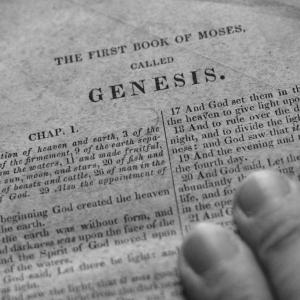
Hand scanning the Book of Genesis. Suzanne Tucker / Shutterstock.com
I didn’t see the film Malcolm X in theaters. I waited to see it on video. Big mistake.
I watched it in my home, just off campus from University of Southern California, late at night when everyone else was sleeping. Another big mistake.
At the time I was living in a house with one other black person and a bunch of white and Asian friends. I was attending a mostly white school and a mostly white church and had attended a mostly white institute for urban transformation that was borne out of my church. Ironically, it was there that I was required to read The Autobiography of Malcolm X. But I never read the whole thing, only sections.
So, I sat in the dark living room, lit only by the television screen, and watched Denzel Washington bring Malcolm X to life … by myself. And there, in the dark, Malcolm’s words about Jesus hit me to the core.
The Oppression Implied in the Confederate Flag

South Carolina state house. Photo by Jimmy Emerson/Flickr.com
As the governor of the first state to secede from the Union, Haley treaded softly on Monday, explaining: Some “South Carolinians view the flag as a symbol of respect, integrity, and duty. They also see it as a memorial. A way to honor ancestors who came to the service of their state during time of conflict.” But, “for many others in South Carolina,” she continued, “the flag is a deeply offensive symbol of a brutally oppressive past.”
Haley explained that it is fine for individuals to fly the Confederate flag on their own private property.
“But, the state house is different,” she declared.
Why is it different and what is the connection to the deaths of Walter Scott and The Emanuel Nine?
Washing Clean: Germany, Ireland, and Our America
It was a devastating weekend for black people in America.
On Friday, a white police officer pulled his gun at a pool party and assaulted a 15-year old black girl who cried for her mom in McKinney, Texas. On Saturday, a young black man committed suicide in his parents’ home in the Bronx after being held without trial at Rikers Island for three years (nearly two in solitary confinement), accused of stealing a backpack — a charge that prosecutors ultimately dropped. On Sunday evening, hotel security officers profiled four young black organizers from Baltimore in the lobby of the Congress Plaza Hotel at the conclusion of The Justice Conference.
A Miracle of Resilience
MY GREAT-GRANDMOTHER, Elizabeth “Lizzie” Johnson, was born in 1890 in Camden, S.C., with a different last name from all the other people in her household. Three generations later, we have no idea where the name Johnson came from.
Lizzie grew up working plantation land owned by her grandmother, Lea Ballard. Lea received the land in the wake of the Civil War: We don’t know how or why, though one theory speculates that Lea, who was listed as a 42-year-old mulatto widow on the 1880 U.S. Census, may have been the daughter of her slave owner. He may have given the land to her after the Civil War. We don’t know. We only know that Lea owned it, that she had 17 children who worked that land, according to family lore, and that the city of Camden eventually stole the land from her by the power of eminent domain. This we know from records I hold in my possession.
Lizzie married a railroad man named Charles Jenkins. Lizzie and Charles had three children; Charles later died in a railroad accident. Lizzie had a choice: endure the brutality of the Jim Crow South alone with three kids, or move with the stream of black bodies migrating north. Lizzie migrated to Washington, D.C., and, eventually, to Philadelphia and took her lightest-skinned child with her.
Baltimore: How Do We ‘Seek the Peace of the City?’
I walked through ash and glass as neighbors and community members swept up the remnants of our neighborhood. The night before, flames touched sky in all corners of our city as news and police helicopters hovered overhead. The city was Los Angeles. The year was 1992, and it was the third day after the police who beat Rodney King were acquitted by an overwhelmingly white jury in Simi Valley.
That was the day I was introduced to the words of Jeremiah 29:7: “But seek the peace of the city where I have sent you into exile, and pray to the Lord on its behalf, for in its peace you will find your peace.”
On Monday, Maryland Gov. Larry Hogan called in the National Guard and Baltimore Mayor Stephanie Rawlings-Blake declared a citywide curfew to quell violence that erupted in Monument City following the funeral of 25-year-old Freddie Gray. Gray died a week after sustaining a nearly severed spinal cord after being detained by police on April 12. The reason for the stop? Gray ran after making eye contact with police. An investigation is ongoing — while the people of Baltimore and beyond demand justice.
The images of fires rising over the Baltimore landscape were eerie, as it was only a few months ago that the nation sat glued to television sets watching the small town of Ferguson, Mo., erupt. And I fear we are becoming numb to it. We turn the TV on to watch our favorite reality show. We see chanting, running black people, and we think: again? Then we turn back to The Voice.
Preparing for Paris
As the world looks toward the United Nations Conference on Climate Change in Paris in December, it would serve us all to reflect on California.
When I moved to California in August 1991, the state’s five-year drought changed the most mundane aspects of life. Throughout my East Coast childhood, this is how I learned to brush my teeth: Turn the knob on the sink, place the toothbrush under the running water, brush, spit, brush again, spit again, place your Dixie cup under the running water, rinse your teeth, gargle, spit, use the running water to rinse the sink of all your spit, then — and only then — turn the water off.
I performed that basic ritual during my first week in Los Angeles. My roommate scowled. She had moved to LA years before and had lived through the state’s drought. Over the course of those five years, every resident of California had taken ownership of the state’s dire situation by altering the daily routines of their lives.
Common measures included: placing bricks in the backs of toilets to use less flushing water, only flushing once or twice a day, only using the absolute minimum amount of water necessary to brush one’s teeth, cooler time-tight showers, and the list goes on.
History records my first months in Los Angeles as the tail end of the state’s late 1980s drought. People danced in the streets of South Central, East LA, and Santa Monica as El Niño’s waters soaked cracked earth in late 1991. But as citizens of a state in crisis, our shared sense of duty had transformed small changes in daily routines into a collective culture of conservation. In fact, to this day, many Californians still practice those same measures.
But it’s been 24 years since those dire days and California is fighting again, slugging into its fourth year of another drought. But this one is different. This is the worst drought in 1,200 years, according to a study published in the American Geophysical Union journal.
Standing in a brown field that should have been packed with several feet of snow on the first day of Earth Month, California Gov. Jerry Brown said: “It’s a different world. We have to act differently.”
Update: Open Letter to Franklin Graham
We want to extend our sincere gratitude to all who signed the Open Letter to Franklin Graham in response to Graham’s original Facebook post on March 7. One month later, the open letter’s original team of writers, along with the Sojourners community, has been deeply encouraged by the broad support the letter has garnered. Thousands of faith leaders across the country have signed the letter with more joining in solidarity every day.
We thought you might be encouraged to see this updated list of principal signatories who have joined their voices to the thousands calling for repentance and reconciliation. Stay tuned for more ways to stay engaged in this conversation.
If you haven’t signed the letter yet, it’s not too late. Click here to sign the Open Letter to Franklin Graham.
Called to Lead, Bank Accounts Be Damned
SHE WAS MAD—fuming.
Thirteen black evangelical leaders rolled across Southern states on a speaking tour of historic black colleges and universities. On a mission to call forth the next generation of black leaders, we traversed the land where our ancestors had worked fingers to bone, drank from separate fountains, and cut loved ones down from trees like dead fruit.
But this is not what made Vera mad.
For the last hour a crowd of black leaders sat, stood, and leaned in as we shared our stories of barriers to advancement within white evangelical organizations. It wasn’t a mean-spirited conversation. It was a needed one—a healing one. Our stories were strikingly similar, even though none of us had worked in the same organization.
Hope Matters
It is Holy Week. And I must admit I’m challenged by it. I’m the kind of person who is much more comfortable in my mind, in words on pages, and in thoughts strung together. I am much more comfortable there than in my body, in my own feet stepping down the street, in my own hips, thighs, calves, swaying arms cutting air, swinging, bobbing, Reebok-ing anywhere.
This wasn’t always the case.
There was a stint in high school, and again in college, and again in grad school, and again in the other grad school when I believed in my body’s capacity to excel — and so it did. I sailed around that high school track multiple times without stopping! I dove for the ball in the students v. teachers volley ball tournament, and I danced: jazz, tap, ballet! In college I rode my bike everywhere. In grad school I did interval training and in the other grad school I did power-walking — and Jenny Craig.
Mind you, all of these periods came in short bursts that propelled me forward for a time and then I would slow down, go into myself, and come out again with another burst in a year or two.
But my last big burst was about eight years ago. I haven’t swayed anything or bobbed anywhere for any significant amount of time since.
I felt it coming on. I knew it was happening when it was happening, but I had no idea I would become consumed by it.
“I just don’t feel like getting up to go walking,” I’d tell myself at my normal walking time.
“What if today is the day I get jumped and raped in the park?”
So I stayed home, convinced I was safer in my bed. Then I moved to a city I didn’t know and the rationalizations took deeper root.
And so, for eight years I have lived like a dualistic gnostic — pushing myself toward spiritual renewal while allowing my body to grow stagnant, stiff, and bloated.
What triggered it? I’ve asked myself that question many times over the years.
A recent event in my life crystalized it for me: Loss had stifled me. A loss locked my feet and knees and would not let me move forward. This loss was loss of hope.
Most of us have that area of our lives where we struggle to hope. For me it is that space down deep where I hide the dream of a family: a loving husband and laughing children and a rockin’ writing and speaking schedule — yeah! It’s my dream.
A Holy Week of Resistance
Someone recently asked me how I answer critics of the Open Letter to Franklin Graham that I co-authored last week. The points of particular interest were these:
1. In the spirit of Matthew 18, how do you justify writing an open letter to Graham without first going to him and speaking with him in private?
2. Your letter seems to advocate disobedience to the police. Is that what you’re saying?
Great questions! They’re especially relevant as we close the season of Lent and look forward toward Holy Week. For it is Holy Week when Jesus himself had the most interaction with the earthly authorities of his day.
The first line of the first paragraph of our letter explained that we write in the spirit of Matthew 18 in order to reconcile. Our intent in that was not to bash Dr. Graham; it was to make him aware of the need for reconciliation.
But why didn’t you go to Graham privately first, some have asked.
Notice the actual language of Matthew 18. Jesus says “If another member of the church sins against you, go and point out the fault when the two of you are alone.”
Jesus does not say, “If another member of the church sins against millions, and hundreds of thousands begin to follow his lead on the issue, go and point out the fault when the two of you are alone.”
This is a very important point. There is a difference between sin that affects one person and the sin of a leader that has potential to oppress and lead the church astray.
In Galatians 2:11-17, Paul publicly confronts Peter when his sin threatens to harm the whole church.
An Open Letter to Franklin Graham
We don’t know what prompted Rev. Franklin Graham to log onto Facebook and pound out the words that lit a firestorm last week. But within one day, tens of thousands of his faithful followers liked and shared his short, patronizing post that called “Blacks, Whites, Latinos, and everybody else” to “Listen up” and tune in to his take on why so many black people have died at the hands of police officers recently. According to Graham, the problem is “simple.” It can be reduced to their lack of obedience and bad parenting.
By Monday morning, more than 80,000 people shared the post and almost 200,000 liked it. Sojourners’ Jim Wallis penned a strong response.
On Friday an evangelical pastor based in Oakland, Calif. (the birthplace of the Black Lives Matter movement), Dominique Gilliard, shared the post with a small diverse group of evangelical leaders who decided to craft a collective response. This open letter was crafted by the collective efforts of Rev. Leroy Barber (CCDA and Word Made Flesh), Gilliard (New Hope Oakland), Dr. Brian Bantum (Seattle Pacific University), Micky ScottBey Jones (Transform Network), Efrem Smith (World Impact) and me (Sojourners). We didn’t know if our words would resonate. We only knew the truth that we must speak in response to Graham’s outsized influence coupled with apparent ignorance. In the end, a broad representation of national evangelical leaders agreed to sign this letter to Graham as principal signatories.
We invite you to read it, discuss it in your churches, and add your name to the many who say “No more!” We will not tolerate this type of flippant, patronizing commentary from faith leaders on critical issues that mean life and death for many in the body of Christ and in communities across America. We won’t tolerate it, even one more day. Rather, we invite all with open hearts to enter into dialogue — and to join us in the ministry of the gospel — the ministry of reconciliation.
We Are Woman
“Mom,” I asked, “why didn’t the ERA pass?”
It was 1982 and I was 13 years old — an age with sharp awareness of what is fair, but with no understanding of the forces aligned to thwart history’s progress. I was unaware of the storm swirling around the Equal Rights Amendment. I was only aware of my mother’s belief that it should pass.
I wasn’t an evangelical, yet – or even a churchgoer. I was simply a girl standing at the precipice of womanhood in a household led by a strong woman who cranked up the car radio whenever Helen Reddy’s “I Am Woman” or Gloria Gaynor’s “I Will Survive” piped through station-wagon speakers.
We are woman! We are strong! We are invincible. We are survivors and we roar!
So, I had no idea that Phyllis Schlafly (a conservative Catholic) and a broad contingent of evangelicals were actively campaigning against the simple amendment that required ratification that year.
The ERA was intentionally simple. Like the 19th Amendment, the heart of the amendment was one sentence long: “Equality of rights under the law shall not be denied, abridged by the United States or by any state on account of sex.”
Seemed simple enough. It was fair. Anything less would be unfair. So how could anyone stand against it?
In Memoriam: Dr. Steve Hayner
It was 1987. I walked across Rutgers University campus with another freshman friend. We were on our way to a meeting for Campus Crusade for Christ (now Cru). In the gobs of our gab we happened upon the topic of the recent scandalous departure of Intervarsity Christian Fellowship president, Gordon McDonald. Interim President, Tom Dunkerton, guided the organization for the next year, appointing Dr. Samuel Barkat as first VP of Multiethnic Ministries. Soon after, Dr. Steve Hayner would accept the mantle of president of the troubled organization. Over the next 13 years, Hayner guided Intervarsity into a period of stability, growth, and racial healing.
Perhaps the most significant contribution of Hayner’s leadership was his close partnership with Dr. Barkat. Together they stood on the sovereign foundations of Intervarsity’s historic struggles toward racial righteousness and guided the organization through a deep examination of its multiethnic dynamics and its white dominant culture. Ultimately, their work led the parachurch collegiate ministry through a transformative examination of its own white western cultural lens and how that lens shaped their understanding of Jesus and the gospel.
